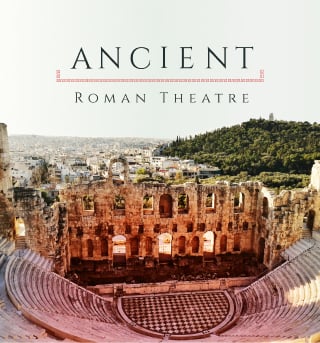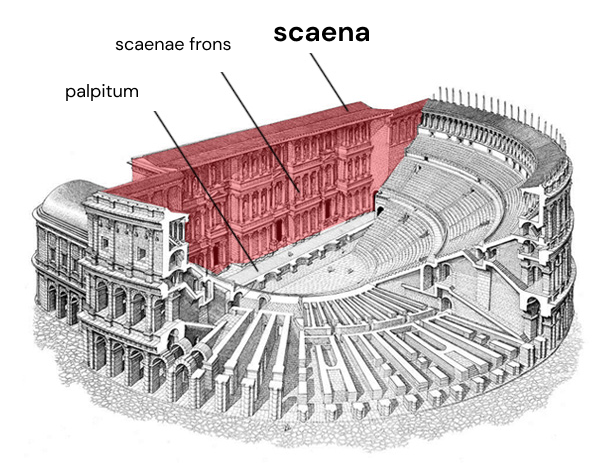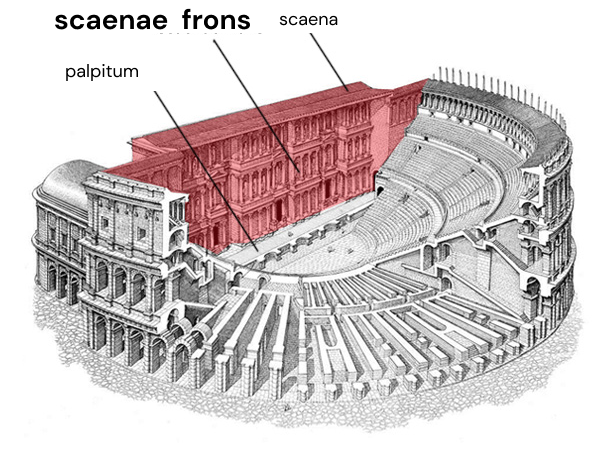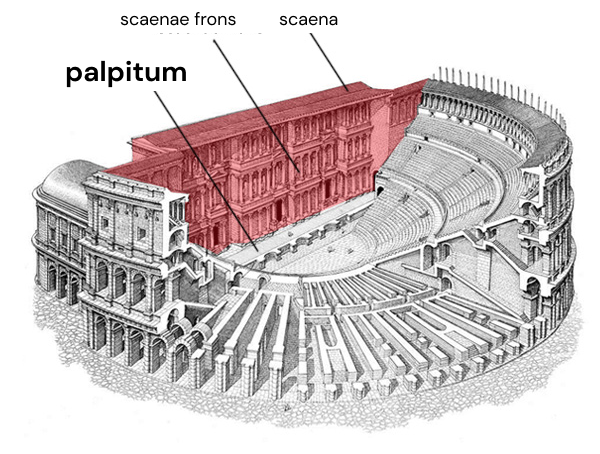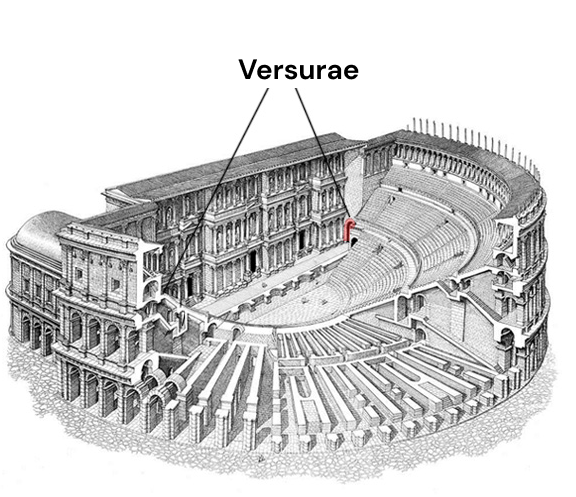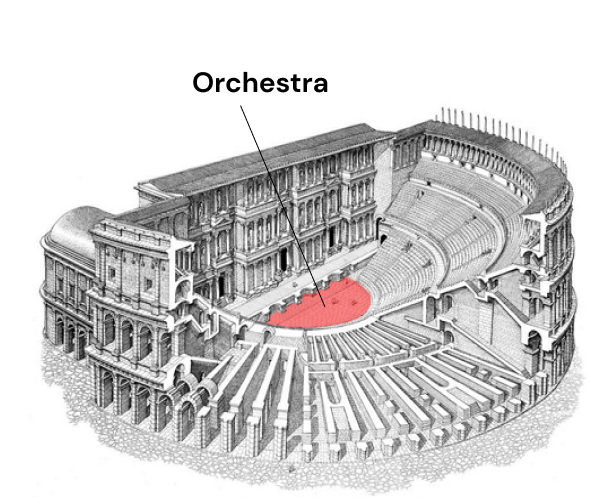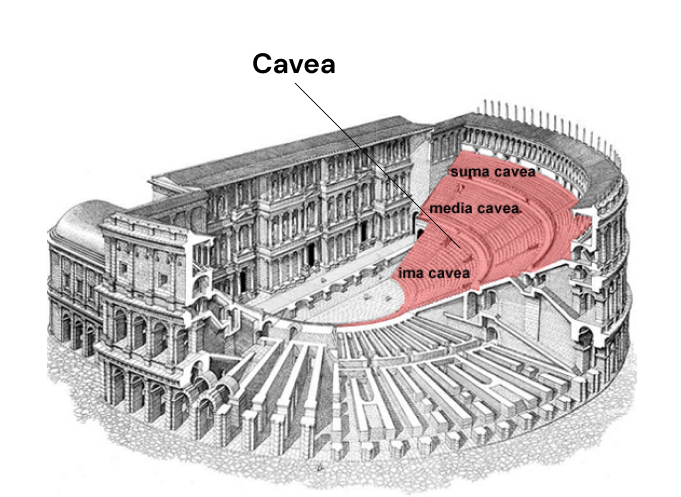The history of Roman theater stretches far back into history. It is thought theatrical performances took place in ancient Rome from the 4th century BC, after the establishment of the Roman Republic. However, most of the earliest known examples of Roman theater come 200 – 300 years later, starting a period that stretches into the 3rd century CE, before the fall of the Roman Empire.
Throughout this era, theatrical performances became a central part of Roman life, often acting as commentaries on society. Works from famous Roman playwrights, including Plautus and Terence, were a considerable influence, even transcending the theater to improve education and literacy in ancient Rome. Such was the quality of their works that many survive and are still performed today.
Roman theater was identifiable via several characteristics, including:
The types of plays written and performed
A preference for entertainment over drama
Common, easily recognizable structures and characters
How actors were viewed and treated in society overall and particularly by those in power
Let’s explore everything you need to know about ancient Roman theater.
The Roman Republic was founded in 509 BC. Over 100 years later, in 399 BC, Romans began performing ceremonies called Lectisterniums. These ceremonies were used as a means of giving offerings to Roman gods. Although not theatrical in themselves, they were a precursor to the development of theater.
An outbreak of plague across the Roman Republic in 364 BC was seen as a sign of the gods’ dissatisfaction at these offerings. Wanting to please the gods and avoid further plagues, Rome’s citizens began including theatrical games and dancing in their Lectisterniums.
It then didn’t take long for these to evolve into organized shows, both as part of the Lectisterniums and independently. At this time, early scripts in the form of short texts were used, while music and choreography also became widespread. What better way to appease a Roman god than to show how much effort you’ve put into organizing a handful of dancers to perform?!
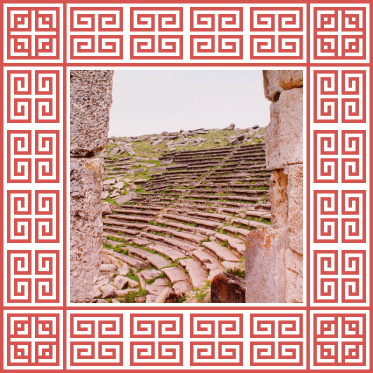
The establishment of theater in Roman culture
By the 3rd century BC, professionally written and performed plays were an integral part of Roman public holidays. These holidays weren’t only days off work or school as many public holidays are in the modern world, but large-scale festivals and celebrations, again, to honor the Roman gods. A notable moment in the development of Roman theater came in 240 BC, when Livius Andronicus, a famous author and playwright, produced translations from Greek plays, which were then performed throughout Rome.
Around the same time, influences from across Italy began to establish themselves within Roman culture.
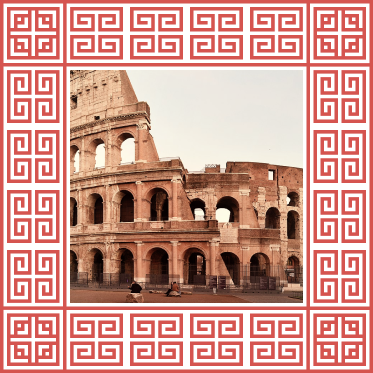
Cultural influences from within Italy and beyond
Some of the earliest types of plays performed in Rome relied heavily on ideas imported from across Italy and even further afield.
These plays included:
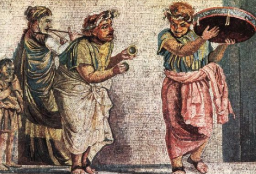
These performances are one of the earliest known examples of ethnic and location-based humor, making fun of people in the town of Atella, which today sits between Naples and Bari. For some reason, citizens of Atella were seen as backward thinking, and citizens of Rome took great pleasure in laughing at this! It is unknown how these plays came into being. It seems likely a traveler from Rome, or a visitor from the south, passed through Atella and returned with embellished stories of their experience of the town.
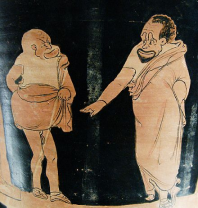
Phlyax plays, also called hilarotragedies. These were burlesque-style shows combining humor with tragedy. There is some uncertainty as to whether these plays were first performed in Rome or ancient Greece. They likely emerged in Greece but looked significantly different once they'd reached Rome via southern Italy.
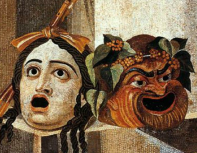
The Fescennine verses were one of the earliest known poetry styles to emerge in Italy, and texts were routinely adapted to be performed as satire or comedy.
Historians have found some evidence, via graphic depictions on vases, that many plays may have been performed in Italian speaking regions first, before being translated into Latin and becoming a component of Roman theater.
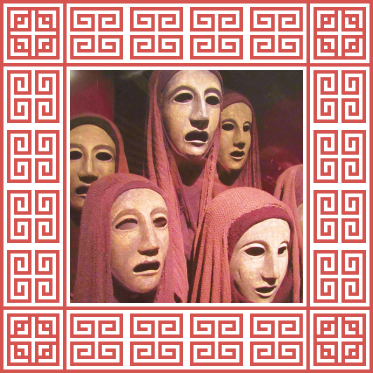
Ancient Greece’s influence on Roman theater
After Livius Andronicus first translated Greek plays for Roman audiences in 240 BC, many dramatic performances in Rome over the next century would be adaptations of Greek plays. These were typically literary dramas and would inspire notable Roman playwrights to begin writing their own productions rather than translating and adapting those from ancient Greece.
As the Roman Republic grew and waged wars in Italy and across the Mediterranean, generals and soldiers would frequently encounter places that had previously taken Greek influences into their culture. In turn, the Romans took elements from these cultures with them upon returning to Rome.
Greece’s sphere of influence over Rome didn’t just cover literature and the theater. Rome widely adopted architectural and even scientific ideas! While the Roman Republic and Empire are widely seen as pioneers for their time, much of their culture was directly taken and adapted from ancient Greece.
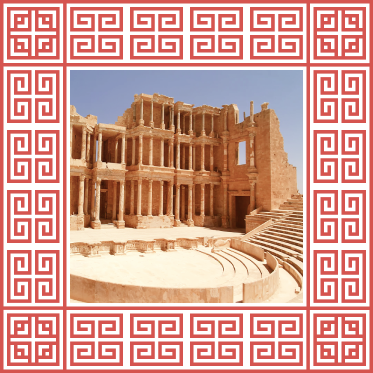
The identity of
Roman theater
While learnings from ancient Greece remained an integral part of many Roman performances, by 100 BC, Roman-style plays had begun to develop and establish themselves.
Instead of drama and storytelling, the focus was firmly on entertainment, with Roman plays almost being what we’d call a circus performance today. Citizens of Rome wanted a spectacle! Singing and dancing was a significant feature of performances, along with mime.
Singing and dancing was a significant feature of
performances, along with mime.
The development of a distinct identity of Roman theater could be seen both through the genres for which plays were written and the recognizable characters featured within them.
In addition to translating and adapting Greek plays, Livius Andronicus was also responsible for writing what are widely accepted as the first works of Roman literature and plays.
One of his contemporaries, Gnaeus Naevius, would also begin writing dramatic scripts, although sadly, works from neither playwright survive today. By 200 BC, professionally produced theatrical performances outside of public holidays were established in Roman culture. Plays were being written to such an extent there was even a writer’s guild!
With Greece’s influence such an integral part of early Roman theater, tragedy and comedy were the first genres to establish themselves within the specific Roman style of theater.
The biggest Roman tragedy of all? No early Roman tragedy plays survive today. It’s only through the work of historians and other documentation that we know how highly regarded tragic productions were in Roman theater throughout the Roman Republic.
Earlier Roman tragedies were notable for their use of chorus, a device not widely used in other genres at the time. This development was in direct contrast to Greek theater, which typically featured chorus sections regardless of the genre of play. Other than the use of chorus, early Roman tragedies aren’t believed to have followed a specific format. However, several different plot devices are thought to have been used.
With a selection of Seneca’s works surviving, more is known about the devices he used to captivate and entertain audiences.
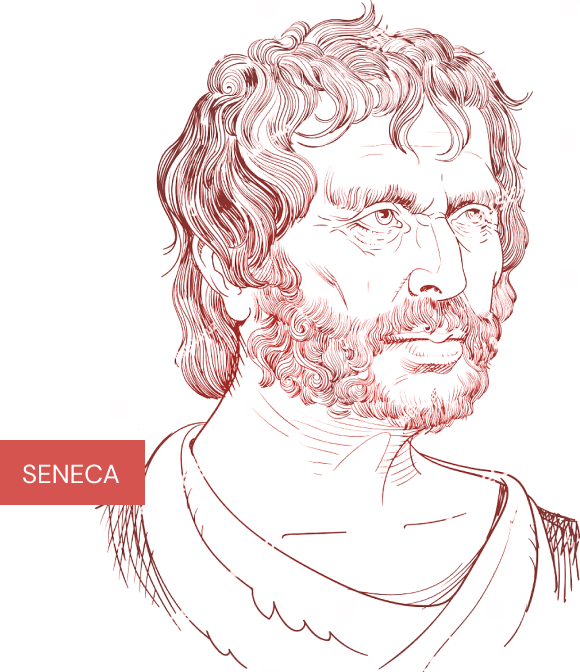
The most notable feature of Seneca’s tragedies is that Greeks were the subject of them all. From this, we can assume Seneca’s work was influenced by his peers’ work and other playwrights who came to prominence in Rome in the last 200 years BC. Seneca was another playwright who used ancient Greek theater as the foundation for his work but preferred to write new plays rather than adapting existing Greek writings.
Seneca’s plays were emphasized by the passion transmitted through both the writing and performance.
Standard features of his work were
-
I
The use of paradox
-
II
Antithesis
-
III
Linguistic discontinuity, designed to be thought-provoking to the audience
-
IV
Hyperbole, which was probably Seneca's favorite means of expression, justification, and persuasion.
Often, these characteristics were shown and used by the central characters in Seneca’s plays. As a Stoic himself, Seneca seems to have had a passion for exploring different layers of characters and giving the audience the chance to learn about the mindset of those in his plays. There was an almost psychological element to much of Seneca’s work. His plays would often include long, self-reflective monologues. These would typically highlight a character’s flaws and set up the story to head towards its tragic ending.
While Seneca was hugely influential at the time from a theatrical perspective, his reach transcended the theater, with evidence that his writing and communication strategies inspired people to change their mindset and how they lived their lives.
In terms of Roman tragedy as a theatrical genre throughout the Roman Empire era and later years, almost everything goes through Seneca.
Although it is known that Roman comedy based in Roman settings was popular during the Roman Republic era, none of these works survive today. Instead, all surviving Roman comedies are either direct adaptations of Greek plays or plays written in Latin but with Greek settings or subjects.
However, adapted plays would often have been unrecognizable from the shows performed in Greece, owing to the level of changes made before they were presented to Roman audiences.
The most significant change was undoubtedly the removal of the chorus. In Greek comedy, playwrights would typically use the chorus to end and start acts and scenes. This helped to divide up the play while also priming the audience that what they’d see next would be a change of scene or a new location.
Instead of using chorus, Roman comedies added music to complement the dialogue as it was being performed. Think about how TV shows and movies today sometimes use background music to provide atmosphere and dramatic effect. Roman comedies performed on stage were doing this from around 200 BC!

-
I
Scenes were often set in the street, outside of the home of the main character or characters. This gave playwrights an easy device for creating comedy out of characters being frustrated; they could simply go “into their house!”
-
II
A typical plot device was using a minor character who would eavesdrop – intentionally or otherwise – on a conversation. These characters would then inform the main characters, advancing the story. This act itself would sometimes be unintentional, giving playwrights another device for creating humorous situations and audience engagement.
In terms of individual playwrights, several Roman comedies written by Plautus and Terence survive today.
At the time, Plautus was regarded as the founder of modern on-stage comedy. As a result of his work, plays again grew in popularity and became a feature of Roman festivals and celebrations.
Terence was born around the same time Plautus died and started writing plays at a relatively early age compared to most Roman playwrights. While Terence is equally celebrated and influential, he was also heavily criticized for much of his work. A trademark of Terence’s plays was combining the plots of several Greek plays into one. This often led to convoluted, complex, and sometimes nonsensical plots that audiences didn’t enjoy.
Whereas Roman comedies, and indeed theatrical productions in general, used a prologue as a scene-setting device, Terence ended up writing prologues that were essentially a plea to the audience to give his work a chance!
As well as the use of familiar scenery and plot devices, it was also typical for Roman comedies to utilize a "stock" cast of characters. While this gave all comedies a similar structure and made it easier for audiences to identify the specific roles being played, it didn't lead to plays feeling repetitive. If anything, it helped playwrights of the age showcase their expertise in taking the same characters and telling new stories in each production.
In total, there were seven characters routinely found in Roman comedies.
A typical Roman comedy would see the adulescens spending his time pursuing love, often of a girl thought to be a street prostitute or slave, known as the virgo. The girl would later be revealed as being “free-born,” meaning she could marry the adulescens.
Sometimes, the adulescens would have a sidekick. This was usually a slave character who would try and solve the adulescens' problems or prevent him from getting into trouble. As you can imagine, in a Roman comedy, this wasn't always successful!
At face value, he always seems to have his son's best interests at heart. He wants to do everything to maintain and improve his relationship with him.
However, the role of the senex wouldn’t always be clear cut.
Depending on the play and the story being told, he might:
- Discourage his son from pursuing the girl he’s in love with
- Help his son win the love of the girl he’s in love with
- Be in love with the same girl as his son, although he’d never win her love
Typically, the senex’s involvement in a Roman comedy ended when his angry wife, the matrona, found him and dragged him back home, a scene that was always good for raising a laugh from the audience!
This character would often create a moral dilemma for the audience. They would never break the law but would generally be seen as immoral and unpleasant individuals.
Typically, this character is a soldier who projects an arrogant attitude while, in reality, being a gullible coward.
However, while the parasitus was a suck-up, he wasn't loyal and would be happy to turn to wherever he could get attention, cash, or food and drink.
The parasitus would often take advantage of the gullible nature of the miles gloriosus for selfish ends.
The matrona would be considered a hugely sexist depiction today! She was presented to the audience as annoying, temperamental, and nagging her husband. However, she was usually concerned with making sure he wasn't pursuing love interests elsewhere, rather than nagging him for the sake of it.
When the matrona did find the senex in the company of another woman, or his affairs came to light through the eavesdropping plot device we highlighted earlier, she would usually be forgiving.
In contrast to her manner towards her husband, the matrona displays unconditional love to her children and always does what she can to help them achieve their desires.
Despite being a central character in many Roman comedies, the matrona often wouldn’t be a speaking part!
She's a unique character, as she doesn't usually feature in the play as a visible performer. Instead, the virgo is spoken of throughout.
The virgo would typically come to prominence at the end of a play with the revelation that the adulescens could marry her. In some productions, it is at this point she would be revealed to the audience, but there would often not be anyone playing the role at all.
Historians believe the first purpose-built theater wasn’t built in Rome until 55 BC. Before this date, temporary wooden structures were erected ahead of public holidays, festivals, and celebrations.
Famously, the Romans were the first civilization to use concrete widely in construction projects. Using concrete led to the Romans building some hugely impressive structures when politicians finally went ahead and authorized permanent theaters.
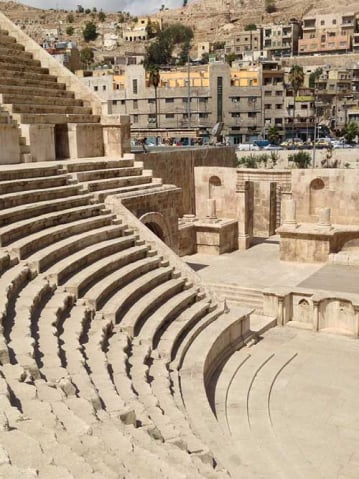
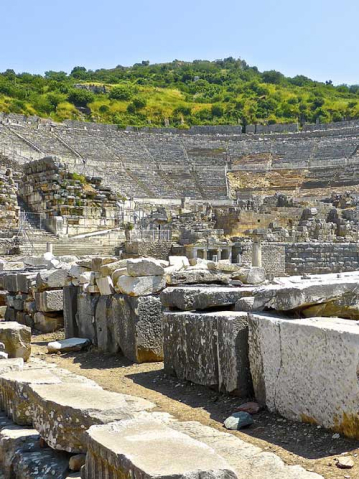
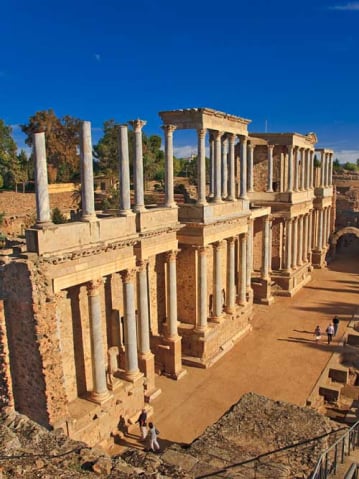
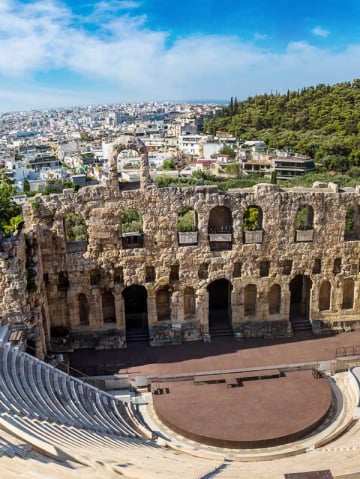
Although Roman theaters’ inspiration came from ancient Greece’s amphitheaters, Roman structures were often far bigger. While Roman theaters were impressive from an architectural standpoint, they were expensive. They also often took generations to build, with contributions from public finances and private benefactors needed to ensure they would be completed. As such, theaters often bore the names of those who had made the most significant contribution or helped to enable projects to be completed. Those who had theaters named for them would subsequently use these as a propaganda tool to further entrench their status and power in Roman society.
Theaters typically had the same layout, encompassing:
Like in ancient Greece, Roman theaters’ seating was divided into zones to control the population and highlight who was in charge. Segregation was always a “rule,” but typically not enforced until the first Roman Emperor, Augustus, demanded it happen.
High ranking politicians or generals were always seated in the orchestra area, ensuring visibility and keeping themselves in the public eye. Behind, rich men would take their seats, while poor men, all women irrespective of status and wealth, and slaves would sit together furthest from the stage.
Roman theater differs significantly from ancient Greece in terms of how actors were used in theater and viewed by the general population.
Unlike in Greece, Roman theater allowed women to play a role in productions. However, women would often be limited to non-speaking parts, even in plays where the female character was a vital construct of the story. Women rarely had speaking roles in Roman plays, and when they did, it would be considered an unusual occurrence.
While some Roman women became successful actresses, it was more common for women to find theatrical success via singing and dancing. Women came to have such a prominent role in Roman theater overall that they even formed a guild, known as the Sociae Mimae.
While actors in ancient Greece were regarded as celebrities – the most famous people behind gods, generals, and the ruling classes – in Rome, they were at the bottom of the food chain.
It was common for actors in Roman plays to be slaves. They were deemed expendable and would often be chastised, beaten, or even killed if they gave a poor performance. In contrast, delivering consistently good performance allowed many slaves to win their freedom.
Even actors who were “free citizens” were lowly regarded, often having the same social status as a criminal or a street prostitute. Part of the logic behind this judgment was that actors were exempt from military service in Rome, which in turn meant they couldn’t ascend to political office. Therefore, many actors were assumed to lack courage and ambition.
Despite very few Roman plays surviving to this day, many notable Roman playwrights were influential at the time, with many seeing their influences live on for centuries.
It is known that he was born in Italy. Still, more comprehensive details of his life's journey around the Mediterranean are unknown. Livius initially worked for a wealthy family in Rome, translating notable Greek works into Latin. He later founded a school where his translations were a critical component of children's education. His translations and productions were later performed for the Roman public and became hugely popular.
Livius was a significant influence on Plautus, who would often take famous Greek plays and re-work them to be relevant and appealing to the humor and tastes of citizens of Rome. Around 20 works of Plautus survive today, with English translations of all of them widely available.
All of Seneca's works were tragedies, although he wrote various other materials such as essays and letters that covered a wide range of societal and moral issues.
While around a dozen plays are attributed to Seneca, it's widely accepted he wrote only eight 100% himself. At least two plays, Hercules Oetaeus and Octavia, are generally accepted to have not been written by Seneca. However, he may have written an earlier version or at least have been the inspiration for these writings.
A handful of Seneca's works survive today, with even those not believed to have written being attributed to him in many modern translations!
Unfortunately, Gaius' influence isn't as strong as it may have been, as other playwrights' attempts to mimic his work often ended in failure, which perhaps led to people unfairly dismissing his work. That said, he remained popular himself, and his plays would attract substantial audiences throughout the 1st century CE.
While Roman theater has undoubtedly influenced modern theater via its surviving works, its reach could have been far more significant. With the deterioration of the Roman Empire and the rise of Christianity, many writings were destroyed purely because they weren’t the “work of God.”
If something wasn’t the work of God, binary thinking and attitudes at the time meant it was the work of the Devil!
Looking further forward to modern theater, the most prominent Roman influence has to be Plautus. His use of poetic meters as a means of creating dialogue would be repeated for centuries.
William Shakespeare
-
The most famous playwright to later use meters in their work, and perhaps the most famous playwright of all time, is William Shakespeare.
-
Shakespeare's work continues to be adapted and performed at theaters and schools the world over, while his work is often quoted in various contexts.
-
Shakespeare’s lineage reaches right back to Plautus, highlighting how influential a humble playwright who lived 2,200 years ago remains today.


